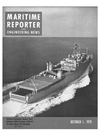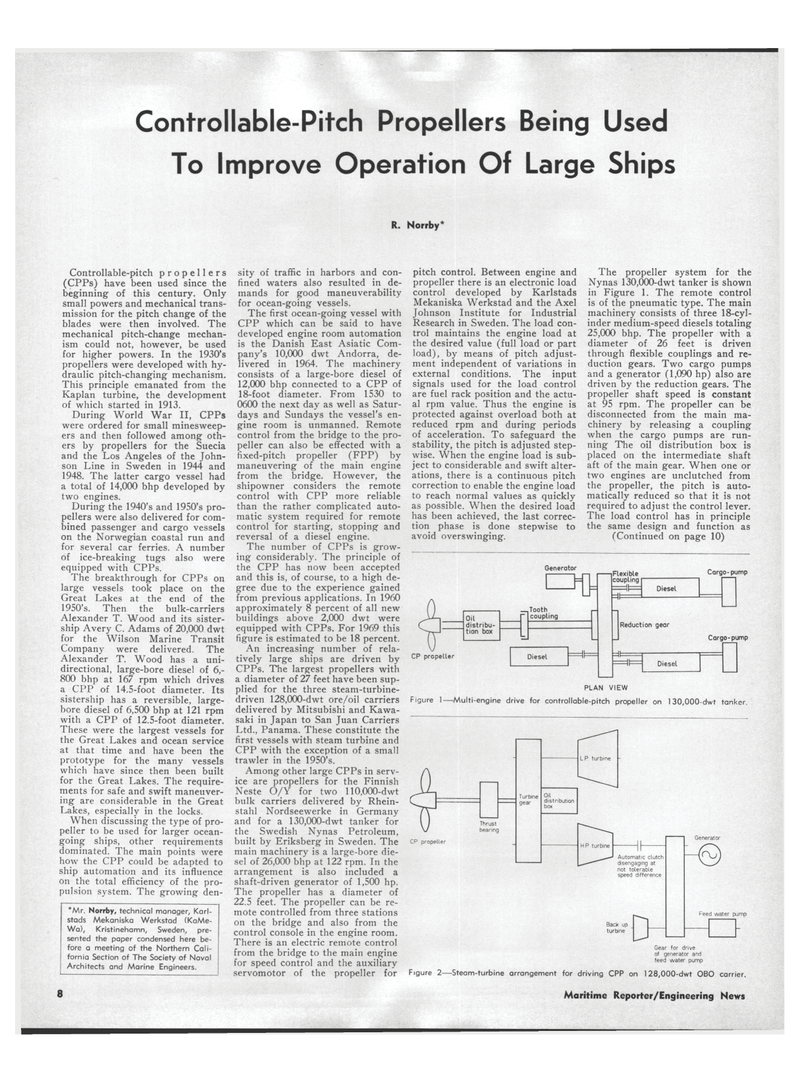
Page 6: of Maritime Reporter Magazine (October 1970)
Read this page in Pdf, Flash or Html5 edition of October 1970 Maritime Reporter Magazine
Controllable-Pitch Propellers Being Used
To Improve Operation Of Large Ships
R. Norrby*
Controllable-pitch propellers (CPPs) have been used since the beginning of this century. Only small powers and mechanical trans- mission for the pitch change of the blades were then involved. The mechanical pitch-change mechan- ism could not, however, be used for higher powers. In the 1930's propellers were developed with hy- draulic pitch-changing mechanism.
This principle emanated from the
Kaplan turbine, the development of which started in 1913.
During World War II, CPPs were ordered for small minesweep- ers and then followed among oth- ers by propellers for the Suecia and the Los Angeles of the John- son Line in Sweden in 1944 and 1948. The latter cargo vessel had a total of 14,000 bhp developed by two engines.
During the 1940's and 1950's pro- pellers were also delivered for com- bined passenger and cargo vessels on the Norwegian coastal run and for several car ferries. A number of ice-breaking tugs also were equipped with CPPs.
The breakthrough for CPPs on large vessels took place on the
Great Lakes at the end of the 1950's. Then the bulk-carriers
Alexander T. Wood and its sister- ship Avery C. Adams of 20,000 dwt for the Wilson Marine Transit
Company were delivered. The
Alexander T. Wood has a uni- directional, large-bore diesel of 6,- 800 bhp at 167 rpm which drives a CPP of 14.5-foot diameter. Its sistership has a reversible, large- bore diesel of 6,500 bhp at 121 rpm with a CPP of 12.5-foot diameter.
These were the largest vessels for the Great Lakes and ocean service at that time and have been the prototype for the many vessels which have since then been built for the Great Lakes. The require- ments for safe and swift maneuver- ing are considerable in the Great
Lakes, especially in the locks.
When discussing the type of pro- peller to be used for larger ocean- going ships, other requirements dominated. The main points were how the CPP could be adapted to ship automation and its influence on the total efficiency of the pro- pulsion system. The growing den- *Mr. Norrby, technical manager, Karl- stads Mekaniska Werkstad (KaMe-
Wa), Kristinehamn, Sweden, pre- sented the paper condensed here be- fore a meeting of the Northern Cali- fornia Section of The Society of Naval
Architects and Marine Engineers. sity of traffic in harbors and con- fined waters also resulted in de- mands for good maneuverability for ocean-going vessels.
The first ocean-going vessel with
CPP which can be said to have developed engine room automation is the Danish East Asiatic Com- pany's 10,000 dwt Andorra, de- livered in 1964. The machinery consists of a large-bore diesel of 12,000 bhp connected to a CPP of 18-foot diameter. From 1530 to 0600 the next day as well as Satur- days and Sundays the vessel's en- gine room is unmanned. Remote control from the bridge to the pro- peller can also be effected with a fixed-pitch propeller (FPP) by maneuvering of the main engine from the bridge. However, the shipowner considers the remote control with CPP more reliable than the rather complicated auto- matic system required for remote control for starting, stopping and reversal of a diesel engine.
The number of CPPs is grow- ing considerably. The principle of the CPP has now been accepted and this is, of course, to a high de- gree due to the experience gained from previous applications. In 1960 approximately 8 percent of all new buildings above 2,000 dwt were equipped with CPPs. For 1969 this figure is estimated to be 18 percent.
An increasing number of rela- tively large ships are driven by
CPPs. The largest propellers with a diameter of 27 feet have been sup- plied for the three steam-turbine- driven 128,000-dwt ore/oil carriers delivered by Mitsubishi and Kawa- saki in Japan to San Juan Carriers
Ltd., Panama. These constitute the first vessels with steam turbine and
CPP with the exception of a small trawler in the 1950's.
Among other large CPPs in serv- ice are propellers for the Finnish
Neste O/Y for two 110,000-dwt bulk carriers delivered by Rhein- stahl Nordseewerke in Germany and for a 130,000-dwt tanker for the Swedish Nynas Petroleum, built by Eriksberg in Sweden. The main machinery is a large-bore die- sel of 26,000 bhp at 122 rpm. In the arrangement is also included a shaft-driven generator of 1,500 hp.
The propeller has a diameter of 22.5 feet. The propeller can be re- mote controlled from three stations on the bridge and also from the control console in the engine room.
There is an electric remote control from the bridge to the main engine for speed control and the auxiliary servomotor of the propeller for pitch control. Between engine and propeller there is an electronic load control developed by Karlstads
Mekaniska Werkstad and the Axel
Johnson Institute for Industrial
Research in Sweden. The load con- trol maintains the engine load at the desired value (full load or part load), by means of pitch adjust- ment independent of variations in external conditions. The input signals used for the load control are fuel rack position and the actu- al rpm value. Thus the engine is protected against overload both at reduced rpm and during periods of acceleration. To safeguard the stability, the pitch is adjusted step- wise. When the engine load is sub- ject to considerable and swift alter- ations, there is a continuous pitch correction to enable the engine load to reach normal values as quickly as possible. When the desired load has been achieved, the last correc- tion phase is done stepwise to avoid overswinging.
The propeller system for the
Nynas 130,000-dwt tanker is shown in Figure 1. The remote control is of the pneumatic type. The main machinery consists of three 18-cyl- inder medium-speed diesels totaling 25,000 bhp. The propeller with a diameter of 26 feet is driven through flexible couplings and re- duction gears. Two cargo pumps and a generator (1,090 hp) also are driven by the reduction gears. The propeller shaft speed is constant at 95 rpm. The propeller can be disconnected from the main ma- chinery by releasing a coupling when the cargo pumps are run- ning The oil distribution box is placed on the intermediate shaft aft of the main gear. When one or two engines are unclutched from the propeller, the pitch is auto- matically reduced so that it is not required to adjust the control lever.
The load control has in principle the same design and function as (Continued on page 10)
Generator
Oil - distribu- tion box -
Tooth coupling
CP propeller Diesel
Flexible coupling =11=
Corgo-pump
Diesel
Reduction gear
Cargo-pump =11=
Diesel
PLAN VIEW
Figure 1—Multi-engine drive for controllable-pitch propeller on 130,000-dwt tanker.
Gear for drive of generator and feed water pump
Figure 2—Steam-turbine arrangement for driving CPP on 128,000-dwt OBO carrier. 8 Maritime Reporter/Engineering News

 5
5

 7
7
